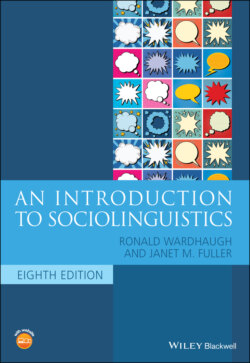Читать книгу An Introduction to Sociolinguistics - Ronald Wardhaugh, Janet M. Fuller - Страница 71
Social Networks
ОглавлениеAnother way of viewing how an individual relates to other individuals in society is to ask what social networks he or she participates in. That is, how and on what occasions does a specific individual A interact now with B, then with C, and then again with D? How intensive are the various relationships: does A interact more frequently with B than with C or D? How extensive is A’s relationship with B in the sense of how many other individuals interact with both A and B in whatever activity brings them together? In a situation in which A, B, C, D, and E are linked in a network, do they all have links to each other or are B, C, D, and E only linked to A but not each other? How people in a social network are linked to each other is one way of viewing social groups as defined by the kinds, frequency, and constellation of social interactions.
Research on social networks in sociolinguistics has proliferated in the last few decades, but is most directly linked to Milroy (1980, 1987; Milroy and Llamas 2013). This work adapted sociological social network theory to sociolinguistics and showed how it could be used in the study of language. Different types of social networks contribute to different pattern of language variation and change (a topic which will be addressed in more detail in chapter 5). You are said to be involved in a dense social network if the people you know and interact with also know and interact with one another. If they do not do so, the social network is a loose one. You are also said to be involved in a multiplex social network if the people within it are tied together in more than one way, that is, not just through work but also through other social activities. People who go to school together, marry each other’s siblings, and work and play together participate in dense multiplex networks. (To see diagrams of these different types of networks, see the page for social network theory on English Language and Linguistics Online, http://www.ello.uos.de/).
In England multiplex social networks are said to be found at the extremes of the social‐class structure. Such networks indicate strong social cohesion, produce feelings of solidarity, and encourage individuals to identify with others within the network. In terms of language use, this means that distinct features are often preserved. On the other hand, middle‐class networks are likely to be loose and simplex; therefore, social cohesion is reduced and there are weaker feelings of solidarity and identity. Within such networks linguistic norms are less well enforced (Milroy 1980).
The social networks of particular individuals are not fixed; they can change, just as the ways in which people speak can change over their lifetimes. People also belong to different networks of different strengths. The availability of computers, smart phones, and other devices has produced entirely new types of social networking which many people now use extensively, and there is now a body of research which looks at how these virtual networks function as speech communities (see Androutsopoulos 2006; Aitchison and Lewis 2003; and Akkaya 2014 for overviews of this research).
Much linguistic behavior seems explicable in terms of network structure and we will see in chapter 5 how valuable the concept of ‘social network’ is when we consider matters of language variation and change (see Milroy and Llamas 2013 for additional details). One of the advantages of a social network approach to the study of social groups is that instead of dealing with abstract categories, it looks specifically at who interacts with whom, and how. In this way it is similar to community of practice research. As noted by Milroy and Gordon (2008, 119), these two methods differ primarily in method and focus: social network approaches look at the ties that foster innovation or the maintenance of linguistic norms, while community of practice research examines how these features are used within group interaction. We will return to this topic and to a discussion of studies employing these frameworks in chapters 5 and 6 as we continue to develop our ideas on language variation and sociolinguistic methodologies.
